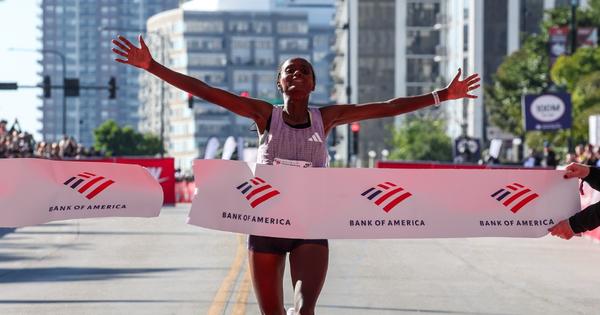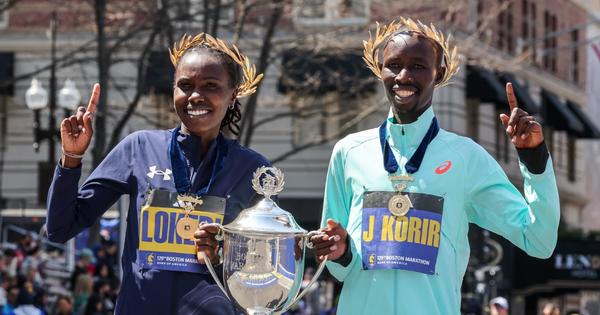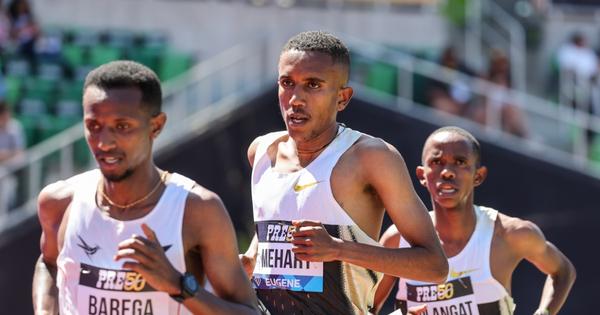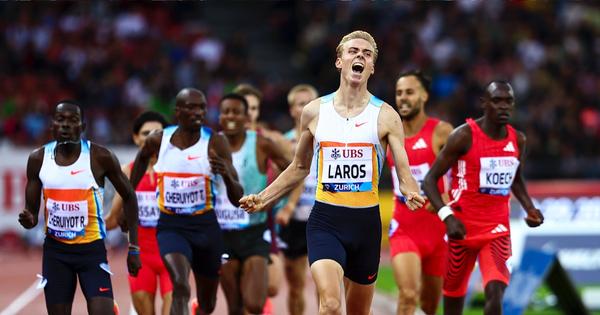By Hannah Borenstein
October 14, 2025
Pre Race
Beyond the usual assortment of running clothes and trainers—plus her racing kit and supershoes—Hawi Feysa packed few additional accessories for her first trip to Chicago. The eventual 2025 Chicago Marathon winner threw in plenty of Maurten drink mixes, vitamin C tablets, and a few options for nail polishes. She’d drink a highly concentrated vitamin C concoction a few days out to beat the minor cold she had been battling, putting five tablets into one liter of water, and sipping the sour mixture while she did a series of stretches and exercises focused on relieving some sciatic pain. But it was when she applied the purple and black nail polish, the hues matching her Adidas kit, that she knew was ready for battle.
Feysa was one of a handful of Ethiopian athletes who had a chance to win the women’s race. Tirunesh Dibaba had been the last Ethiopian woman to win the race, back in 2017, but this year it seemed one of the many marathoners in the field who looked up to her early in their careers could bring the title back to Ethiopia. While the men’s race held the allure of a possible world record, the women’s promised something different: a guaranteed first-ever Major marathon winner and a wide-open field. Many eyes were focused on Megertu Alemu—who came in with the fastest seed time, 2:16:34—and Ejgayehu Taye, who was debuting at the distance but brought to the table years of track prominence and a half marathon time of 64:14. But it was Feysa who would take off at the start line and never look back.
Working as the elite athlete interpreter, I get to spend a lot of time with athletes leading up to the race. The press conference is not typically revealing; athletes often don’t want to show their cards or indicate that they have any weaknesses heading into the race. Ethiopians also tend to keep things particularly low key before races; they try to sleep a lot. A long travel journey and a major time difference is hard to overcome in just a few days and Ethiopian runners value sleep as a prized mode of recovery. When they’re not running alongside Lake Michigan or eating in the dining hall, they’re most likely found to be snoozing between any and all obligations.
Feysa told me after winning she only slept two hours the night before the race but she had many hours stored in the two days prior. In addition to banking that kinetic energy, she was hoping to absorb some functional treatment she received on Thursday.
Eric Lilot, a member of Feysa’s management team, brought in a Chicago-based chiropractor, Dr. Ryan Verchota, of Optimal Performance movement, to help release some tension in her lower back the Thursday before the race. Dr. Ryan (as he is known) and his team treat many of Chicago’s best athletes, and even before setting up in Feysa’s room, she was offering him kolo—a traditional snack from Ethiopia comprised of fried and spiced barley, chickpeas, peanuts, and other grains. Ethiopian runners tend to bring kolo to competitions. They also used to, and occasionally still bring besso—a flour made from roasted barley to be mixed with sugar and water to make a thick recovery drink—to competitions, but now many (like Feysa) opt for Maurten.
Dr. Ryan politely waited until after the treatment to indulge but joked he hadn’t been taken so well care of by a client in quite some time. As he gradually worked to release the pressure in her lower back, Feysa asked many questions, at times pulling up YouTube videos she had been trying to find the right stretches and exercises.
“Not every athlete is as curious as [Feysa],” he said. “Most elite athletes are very in touch with their bodies, but not all are as interested in learning about how things are connected and moving. Even with limited resources and language, it was very cool to see her trying to understand how her tissue operated.”
After the session, Feysa smiled and offered Dr. Ryan kolo again. He took his first handful, threw it in his mouth, and beamed and nodded as he enjoyed, eliciting a bigger smile and giggle from Feysa. “Eat, eat!” she encouraged him afterwards. Then, through me, invited him to visit Ethiopia.
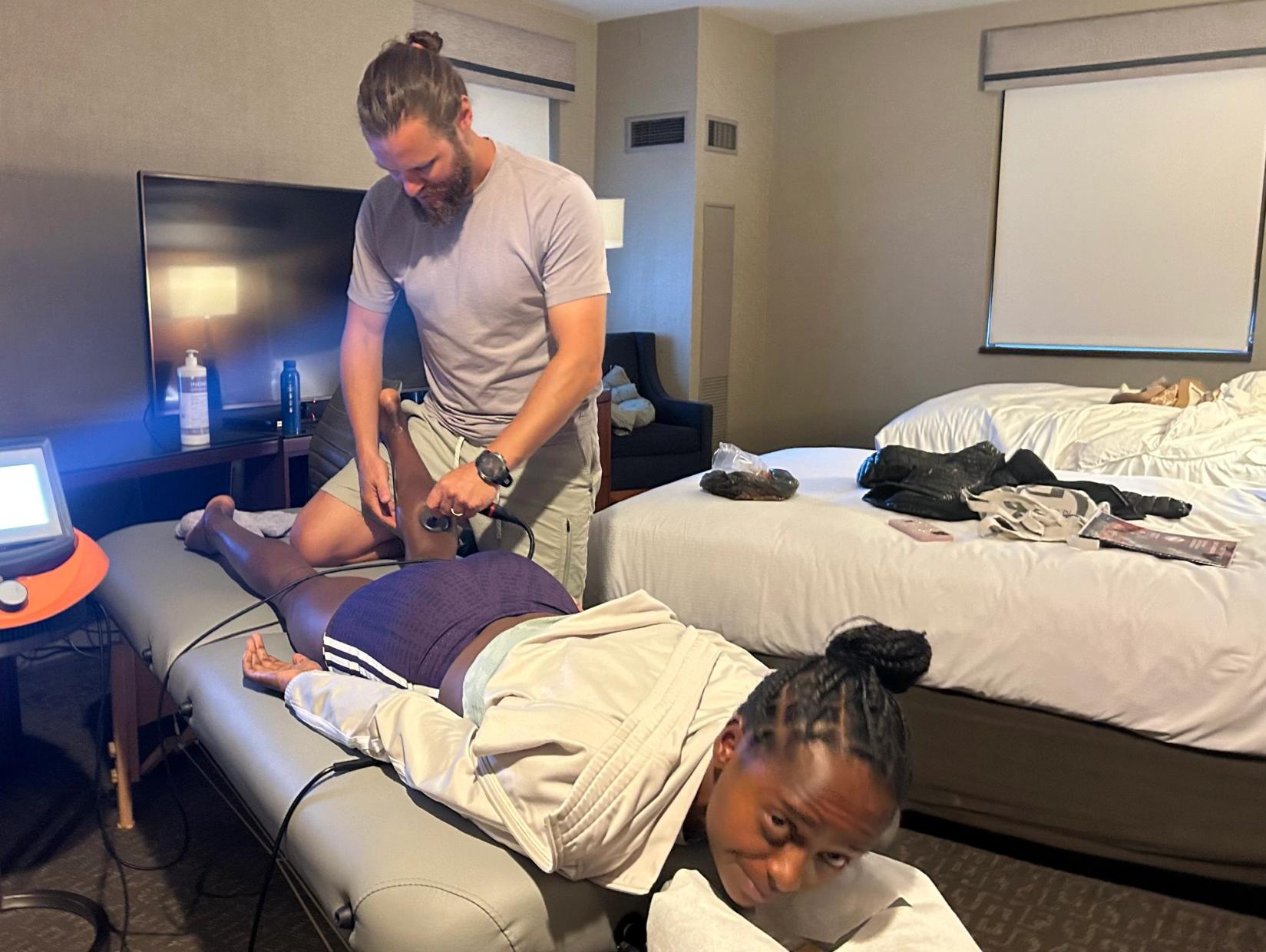
The Race
When her wake-up call came, Feysa had already been up for a while. She didn’t feel stressed. She just couldn’t sleep. At the technical meeting the day prior we learned that her pacemaker and training partner, Chala Beyo Techo, was set to take her through the half marathon at 67:00 and run 40 kilometers, setting an even pace.
“Hawi is the epitome of someone who is completely dedicated to her craft and she is admired by her coaches, training partners and team,” Lilot said. “She has complete confidence in her training program and when I asked what pace she felt comfortable with for the race she simply said ‘whatever coach wants and decides I will follow.’ It goes without saying that her marathoning future is very bright.”
The only other athlete to accompany Feysa and her pacer was Tanzanian record holder, Magdalena Shauri, who at times seemed to want to push the pace, urging the pacemaker to go faster than his assignment. However, the Ethiopian pair decided to reign in the aggressive pace, allowing Shauri to tire herself by surging, and came through the halfway point at exactly 67:30, the later adjusted pace. But Alemu, a talented marathoner, trailed only seven seconds behind with Taye beside her. By 30 kilometers, Shauri had fallen off the pace and Alemu, with the help of her own pacemaker, nearly reeled in Feysa, running just 5 seconds behind.
It seemed for a few miles that Alemu may have run a more measured race, but even as Feysa’s pacemaker dropped out earlier than his assigned 40 kilometers, she slowly began to pull ahead. “It was windy, and then Chala had to stop, so by 30k I was alone,” she told me after the race. “That was the hardest part.” But Feysa ran remarkably consistent splits, and Alemu and Shauri fell further back.
Accelerating towards the finish, Feysa ran hard, threw her hands up, her purple and black nails glistening in the morning sun, and broke the tape. Then she fell to her knees and thanked God for answering her prayers. A fixture on the global running scene for some time, switching between events and sponsors, now everyone would know her name.
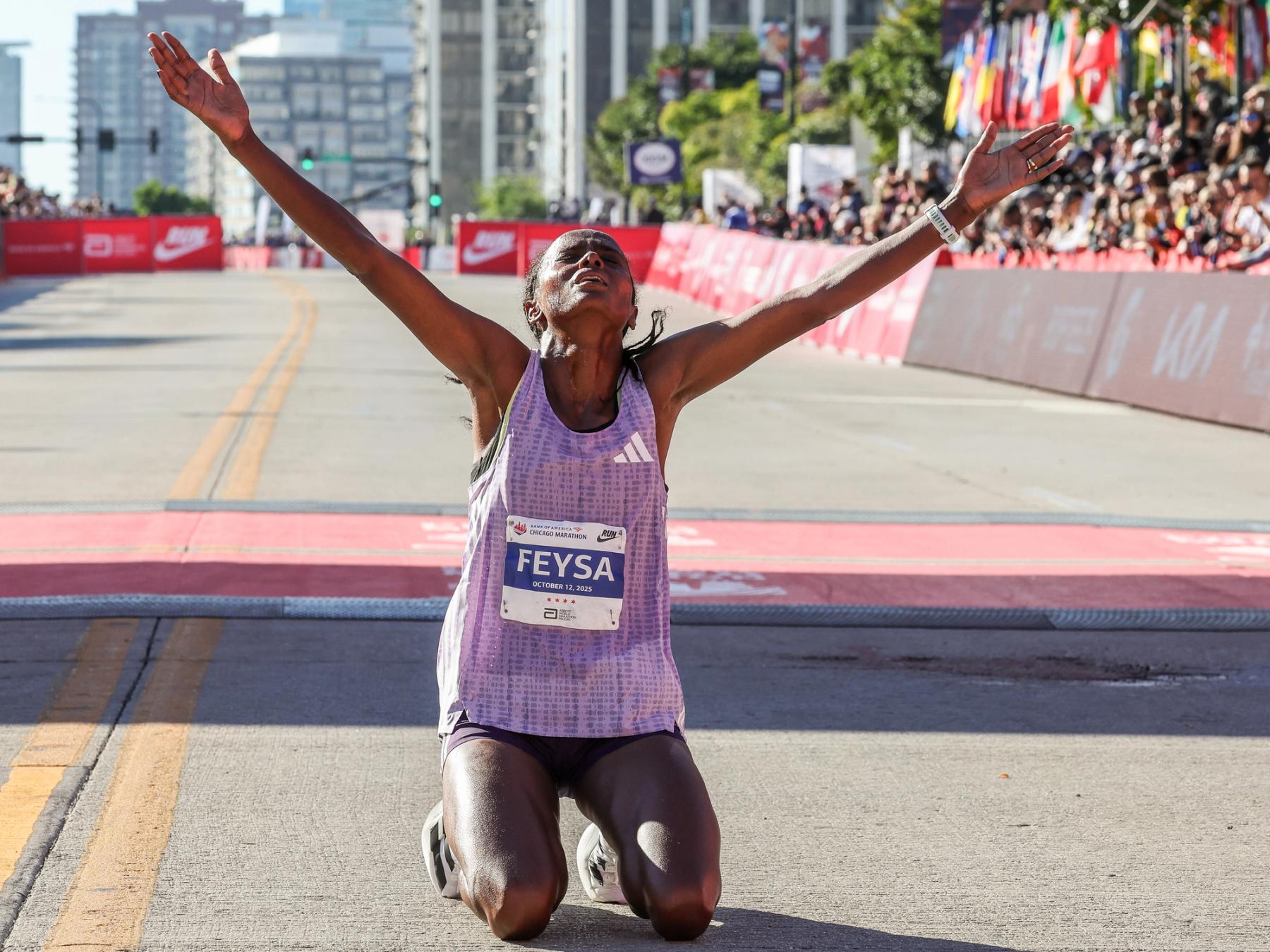
Hawi Feysa | Photo by Kevin Morris / @kevmofoto
Processing the Race
While I’ve worked at the Chicago Marathon previously, I hadn’t ever accompanied a victor through the post-race obligations and festivities. In addition to helping translate Feysa’s initial sentiments following the race, I, humbly, got to experience much of her immediate post-race emotions and reflections alongside her. After about 10 minutes of finish line photos and celebrations, she and the other podium finishers were ushered into a tent to change their clothes, get some water, and meet the USADA officers who cannot leave their side until they can provide urine samples for drug testing. After a marathon, this can take quite some time (and it did).
Carey Pinkowski, the race’s executive race director, presented the awards to the top three finishers, gave each of them a Chicago flag and flowers, and took a bunch of photos. Then the organizers finally brought Feysa and Jacob Kiplimo back to the hotel on golf carts. When we arrived at the hotel, we went straight to the media center, where the champions sat for a brief press conference.
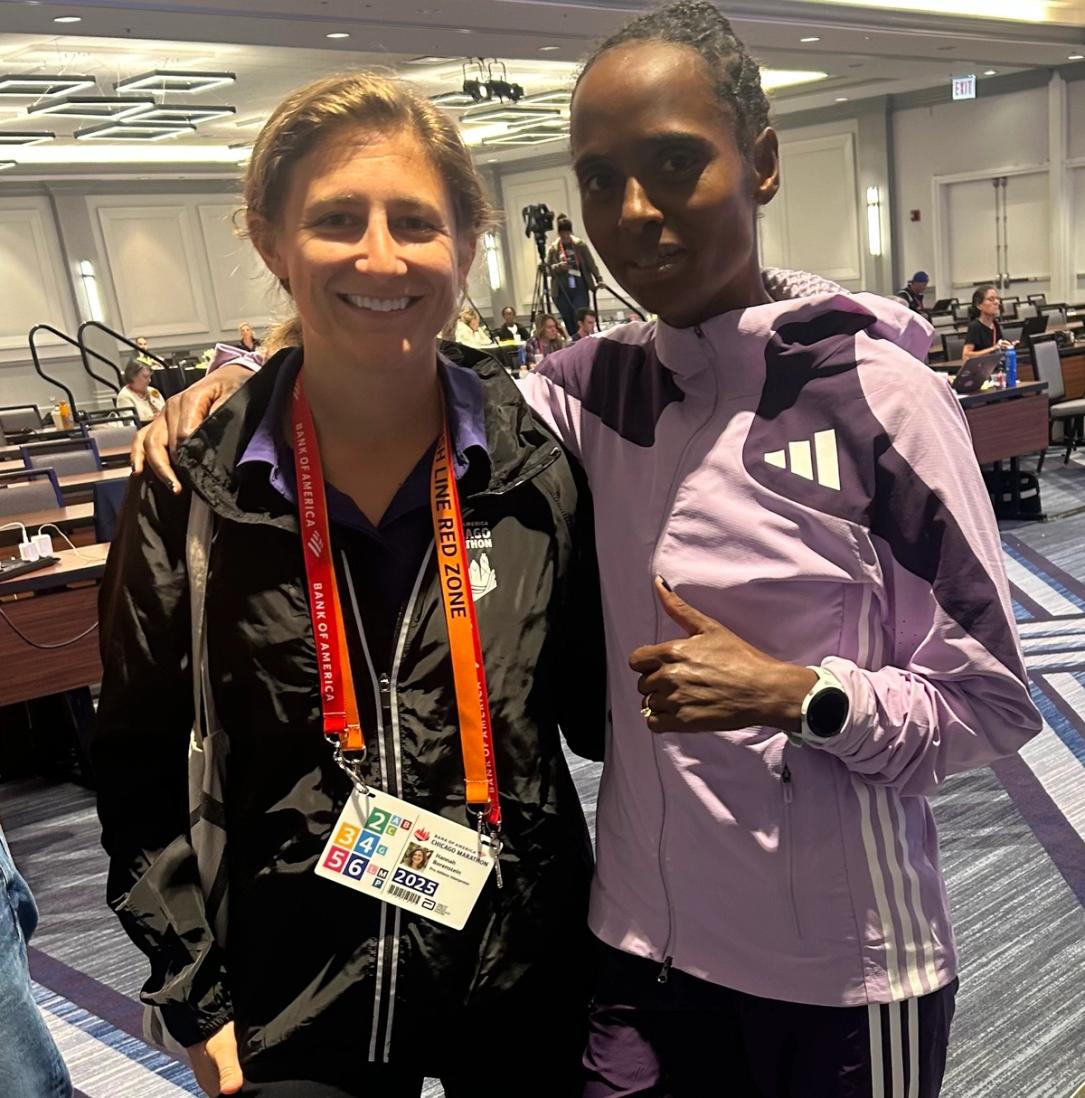
It was there that Feysa learned she broke 2:15. She had barely begun to process her victory when she asked me what time her compatriot, Alemu, ran. It was then, when we began looking at the Chicago Marathon app together, that she saw her time of 2:14:56. Suddenly, a smile even bigger than the one I had witnessed when she saw Dr. Ryan liked kolo, appeared on her face. “When I looked up before finishing, like, I swear I saw 2:15:03, or 2:15:04,” she said, “I thought I just missed it.”
Her previous personal best was 2:17:00, which she ran in March at the Tokyo Marathon. Running under 2:15 was something Feysa and Alemu both talked about leading up to this race; however, it’s one thing for an athlete to say they’re going to do something, and another to actually do it.
A few journalists asked about Feysa’s exemplary pacing, running nearly even splits. To that, she repeatedly credited her coaches and training partners. She trains under Gemedo Dedefa, who also coaches Tigist Assefa (2:11:53), Amane Beriso (2:14:58), and Tigist Ketema (2:16:07). They do a lot of training sessions together, running paces to prepare for marathons in the 2:13 – 2:14 range. When Feysa’s pacemaker dropped off early, she knew running fast would be a tall order, but still pushed, focusing on her own rhythm. Even when women in the chase pack temporarily neared, she told me after she never thought much about what was going on behind her.
It’s an interesting experience to watch a professional athlete process their race, throughout the day, in different settings. As an observer, and someone through whom she was communicating with others, I saw different stages of realizing the achievement, and what this could mean moving forward, in real time.
It was not until after the press conference she saw her coach. He watched her on stage and when I waved him over he jogged to give her a big hug and congratulate her on such a major accomplishment. “Six months,” she later told me. “I had been preparing for and thinking about this race for six months, nothing else.” And you could tell, by the way she hugged her coach, it had been a long journey.
Then, Feysa was hungry. Even though she had already downed a few bottles of water, she knew she was far from ready to provide a urine sample for USADA and felt dizzy from the sugar low. She and her coach chatted in depth about the race over rice, spaghetti, and chicken, and then we all went up to drug testing together. The USADA chaperone was relieved to drop her off, because she had to pee herself, but Feysa told me, several water bottles deep, “not yet.” She received numerous phone calls from Ethiopia as she sat over the Telegram messaging app, sipping water and Gatorade, getting to enjoy the outpouring of evening phone calls coming in from Ethiopia.
In these small unglamorous rooms after races, you really get a glimpse at what these athletes put themselves through over the course of 26.2 miles. While many recreational runners are out celebrating, drinking beers, and reconnecting with loved ones, professionals sit and stand, their muscles simultaneously screaming at them to move and rest, until their depleted and dehydrated bodies can absorb enough liquid to allow them to urinate and go about their days.
Just after 1 p.m., Feysa finally looked at me, and gave a single nod. She was ready.
Celebrating the Race
At 3:30 in the afternoon, Chicago Marathon champions, Feysa, Jacob Kiplimo, Susannah Scaroni, and Marcel Hug, went across the street to meet and take photographs with a group of people from Abbott, the health care company that sponsors the World Marathon Majors. As we crammed in an elevator, Feysa told me in Amharic, “I always see [Scaroni and Hug] on television; they’re always winning.”
As we walked down a few steps to meet the Abbott team, she noted that Kiplimo, who was leaning on the railing, was struggling to handle the impact. “He’s so sore,” she remarked empathetically. “I’m actually okay,” she said. It was the best she’d felt after a marathon. “But after my second marathon,” she added, “I looked like that.”
After many photos one woman came up to Feysa and asked, through me, “What do you think about when you race?” Her answer was brief. She thinks about her form, her pace, and tactics. It can be disappointing to sometimes hear that the focus is so narrow. Feysa is not thinking about the city of Chicago, how much she loves running, or her family back home. She then added, instructively, “When you are running, in racing and training, you cannot give your focus to other things.” It’s the preservation of the focus on the simple, but immensely hard task of running so doggedly for so long, that is a real psychological gift of many of the world’s best, even if it doesn’t exactly help them be more relatable to the masses.
Feysa’s last obligation, and our final hours spent together, came at the champions reception that evening. Before being celebrated on stage, Feysa told me she was excited to take a month off from training. During this time she takes rest and recovery seriously; she’ll spend a lot of time praying, listening to spiritual songs, and restoring all parts of herself.
When she returned to Ethiopia Tuesday morning, as is customary, she was likely greeted by a large contingent with flowers at the airport. Among her supporters were her husband, Gemeda Asegid, Coach Dedefo, some teammates, and her three younger sisters. Feysa is the fifth child in a family of 11 children. She comes from Ambo, Ethiopia, a town in the western part of the Oromia region, known for its mineral water that gets bottled for all of Ethiopia to drink. She supports both her family back home and her sisters who have come to live with her.
While Feysa is the first in her family to run competitively, she might not be the last. Since making money in running, her three younger sisters have come to live with her in Sululta, a town just outside of Addis Ababa where many runners reside. She supports one who is pursuing an education, and helps the other two who are now training on the track. Her sister, Tarike, might be one to watch for in the future, as Feysa thinks there’s a chance she reaches her level. But Feysa, 26, is far from finished. Her future is bright and glossy. Just like her nails.
Keep up with all things track and field by following us across Instagram, X, Threads, and YouTube. Catch the latest episodes of the CITIUS MAG Podcast on Spotify and Apple Podcasts. For more, subscribe to The Lap Count and CITIUS MAG Newsletter for the top running news delivered straight to your inbox.

Hannah Borenstein
Hannah Borenstein is a writer and professor of Anthropology at Florida International University. She researches and writes about the intersections of gender, race, labor and running, with a particular focus on Ethiopia.
